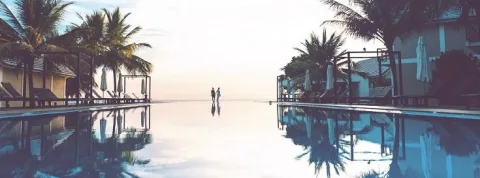
Luxury tourism: definition & trends
Flights in first or business class, stays in palaces or 4-star hotels, getaways to prestigious destinations… Is that really, today, the definition of luxury tourism? What is luxury tourism in 2025? Behind these clichés lie new expectations, tailor-made experiences, and increasingly varied examples of luxury tourism, to be discovered in this article.
Definition of luxury tourism
What is luxury tourism? Long associated with a certain level of comfort — first class flights, 5-star hotels, prestigious destinations — luxury tourism is no longer merely about the accumulation of outward signs of wealth. Today, it primarily embodies a quest for exclusivity, personalisation, and emotion.
The definition of luxury tourism now rests on the experience lived by the traveller. They seek excellent service, of course, but also constant attention to their desires, a unique setting, absolute discretion and a real added soul. It is no longer just about consuming a journey, but living a rare and tailor-made moment.
In this context, luxury tourism takes many forms. For some, it will be a private safari in Africa with a personal guide; for others, a wellness retreat in a high-end ecolodge in Costa Rica, or a sailing cruise in the Greek islands, far from traditional tourist circuits.
Concrete examples of luxury tourism
To meet the ever-increasing expectations of travellers seeking exception, premium hospitality professionals now focus on exclusivity, innovation, and refinement in every detail. In France, true cradle of luxury, several emblematic establishments perfectly illustrate this new approach.
Le Meurice, a historic palace in the heart of Paris, embodies French excellence on its own. Its Belle Étoile Penthouse Suite, with its sumptuous decor and panoramic terrace offering a 360° view of the capital, is a concrete example of luxury tourism where comfort combines with the magic of the place. A rare experience, reserved for a select few.
In a similarly prestigious style, the Plaza Athénée cultivates a haute couture spirit that attracts an international clientele. Between ultra-personalised service, expert concierge and elegant atmosphere, the hotel offers tailor-made stays reflecting the greatest French fashion houses.
Always at the forefront, the Barrière group innovates by integrating Foodtech codes into its 120 bars and restaurants: customisable menus, immersive experiences and digital interactions enrich the gastronomic experience, without ever compromising quality.
Finally, the Ritz Paris, living legend of Place Vendôme, offers its guests a moment of absolute well-being through its Chanel Spa, signature treatments and intimate ambiance. Here, luxury is experienced in softness, discretion and bespoke service.
Major current trends in the sector
Tailor-made and personalisation
The trends in luxury tourism? Tailor-made! Traveller expectations for personalisation have never been so strong. They no longer hesitate to impose their preferences: room number, specific table in a fine restaurant, grand cru reservation, particular location on a boat... In terms of transport, luxury clients are increasingly demanding: optimised services, seamless waiting times in airports, transfers by private helicopter.
Sustainability and authenticity
Far from flashy luxury, a new form of high-end tourism is focusing on sustainability, authenticity, and respect for local cultures. Eco-luxury is gradually becoming a standard: eco-responsible accommodations, short supply chains, solidarity initiatives, encounters with local communities… Hotels like Six Senses, Soneva or the Singita lodges in South Africa prove that it is possible to combine refinement, immersion and ecological awareness.
Millennial influence
Often seen as less attached to traditional luxury, Millennials are redefining the codes of the sector. Their idea of luxury is more about experience than possession. They favour unusual stays, cultural discoveries, intense emotions. A night in a bubble in Lapland, a road trip in a premium van or a wellness stay in a Zen temple in Japan can feature among their choices. Their quest? Authenticity, spontaneity, but with comfort and style.
Digitalisation and Instagrammability
It is now impossible to talk about luxury tourism without mentioning the digitalisation of the customer experience. Bookings via smartphone, online personalised services, virtual reality to visit the suite before departure... digital is present at every stage of the journey. Moreover, the “Instagrammability” of a place has become a key criterion: spectacular views, immersive decor, carefully designed aesthetics... Luxury establishments increasingly focus on the “wow factor” to attract a clientele eager for visual content to share.
The luxury tourism market in figures
It is estimated that by 2028, spending on luxury tourism could reach 391 billion dollars compared to 239 billion in 2023, with an annual growth of around 11%.
In France, the luxury hotel segment shows remarkable performance. Average prices have increased by 48% compared to 2019 and by 9.6% compared to 2022, reflecting sustained demand for high-end establishments.
The preferences of wealthy travellers are also evolving. A study conducted by ILTM, Hyatt and Altiant reveals that 54% of the 800 affluent travellers surveyed have already taken part in a wellness-focused stay and wish to repeat the experience. Moreover, 62% consider wellness facilities in hotels to be very important, while 84% consider personalised wellness services adapted to their health goals to be essential.
Flagship luxury tourism destinations
The top luxury destinations? According to the Virtuoso Luxe Report, the most sought-after destinations by wealthy clients in 2019 were of course Italy, France, and then South Africa. At the top of emerging destinations were Japan, followed by Croatia and Iceland. Luxury travellers who travel as a family first choose Italy, then Mexico and Hawaii. As for Millennials, they favour Italy, Thailand and Iceland.
Synergies between luxury and tourism
Luxury and tourism share the same ambition: to offer exceptional experiences. Their relationship is not new, but it is intensifying as luxury brands invest in the world of travel, and tourism players adopt luxury codes to attract a demanding clientele.
Luxury houses are becoming hoteliers, like Bulgari, Armani, or Cheval Blanc (LVMH), creating their own hotels and resorts. These establishments offer far more than accommodation: they propose a complete universe, faithful to the brand’s DNA, where design, service and art of living come together. In return, these hotels allow the brand to broaden its influence, embodying its lifestyle beyond its traditional products.
Conversely, major tourism players are adopting luxury codes: inspiring storytelling, extreme attention to detail, collaborations with starred chefs, high-end spas or immersive experiences designed like works of art. Travel becomes a vector of emotion, a way to create a privileged link with the client, just like a fashion house would.
As Thibaut de La Rivière, director of Sup de Luxe, points out, “The great names in fashion, design or automotive propose partnerships, like Cheval Blanc by LVMH with a future opening in Paris on the former site of La Samaritaine, the Bentley Suite at the St. Regis in New York with access to a Bentley Mulsanne, or Le Bristol with Les Samedis de la Mode which will host a Brioni event at the end of November after the Brazilian fashion shows in October...”
Discover our programme: MSc in Food and Wine International Management | Sup de Luxe
